light FIAT TALENTO 2021 Owner handbook (in English)
[x] Cancel search | Manufacturer: FIAT, Model Year: 2021, Model line: TALENTO, Model: FIAT TALENTO 2021Pages: 236, PDF Size: 4.86 MB
Page 128 of 236
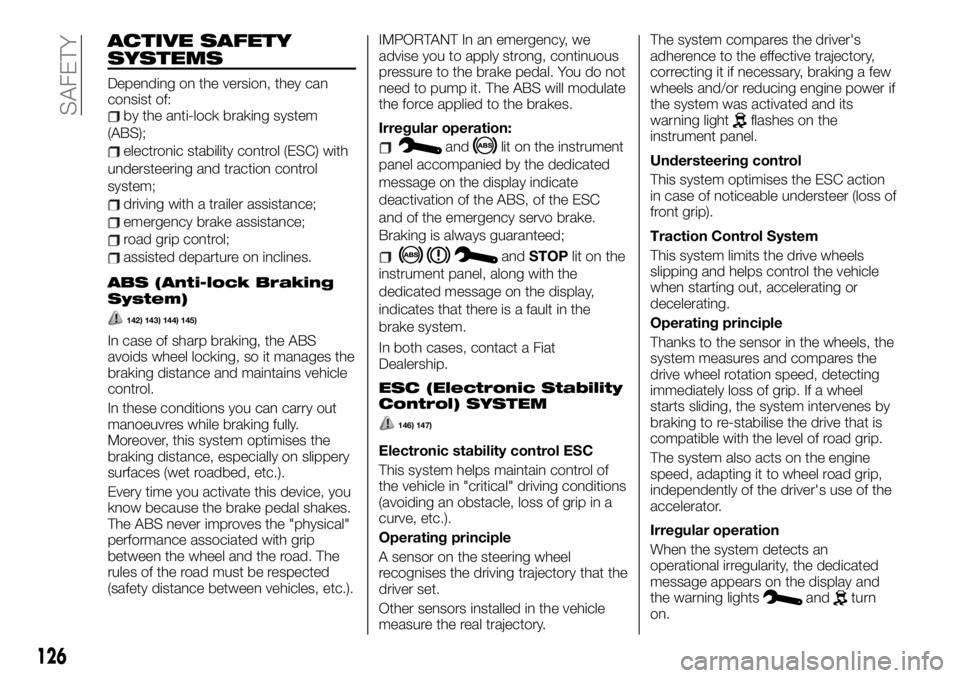
ACTIVE SAFETY
SYSTEMS
Depending on the version, they can
consist of:
by the anti-lock braking system
(ABS);
electronic stability control (ESC) with
understeering and traction control
system;
driving with a trailer assistance;
emergency brake assistance;
road grip control;
assisted departure on inclines.
ABS (Anti-lock Braking
System)
142) 143) 144) 145)
In case of sharp braking, the ABS
avoids wheel locking, so it manages the
braking distance and maintains vehicle
control.
In these conditions you can carry out
manoeuvres while braking fully.
Moreover, this system optimises the
braking distance, especially on slippery
surfaces (wet roadbed, etc.).
Every time you activate this device, you
know because the brake pedal shakes.
The ABS never improves the "physical"
performance associated with grip
between the wheel and the road. The
rules of the road must be respected
(safety distance between vehicles, etc.).IMPORTANT In an emergency, we
advise you to apply strong, continuous
pressure to the brake pedal. You do not
need to pump it. The ABS will modulate
the force applied to the brakes.
Irregular operation:
andlit on the instrument
panel accompanied by the dedicated
message on the display indicate
deactivation of the ABS, of the ESC
and of the emergency servo brake.
Braking is always guaranteed;
andSTOPlit on the
instrument panel, along with the
dedicated message on the display,
indicates that there is a fault in the
brake system.
In both cases, contact a Fiat
Dealership.
ESC (Electronic Stability
Control) SYSTEM
146) 147)
Electronic stability control ESC
This system helps maintain control of
the vehicle in "critical" driving conditions
(avoiding an obstacle, loss of grip in a
curve, etc.).
Operating principle
A sensor on the steering wheel
recognises the driving trajectory that the
driver set.
Other sensors installed in the vehicle
measure the real trajectory.The system compares the driver's
adherence to the effective trajectory,
correcting it if necessary, braking a few
wheels and/or reducing engine power if
the system was activated and its
warning light
flashes on the
instrument panel.
Understeering control
This system optimises the ESC action
in case of noticeable understeer (loss of
front grip).
Traction Control System
This system limits the drive wheels
slipping and helps control the vehicle
when starting out, accelerating or
decelerating.
Operating principle
Thanks to the sensor in the wheels, the
system measures and compares the
drive wheel rotation speed, detecting
immediately loss of grip. If a wheel
starts sliding, the system intervenes by
braking to re-stabilise the drive that is
compatible with the level of road grip.
The system also acts on the engine
speed, adapting it to wheel road grip,
independently of the driver's use of the
accelerator.
Irregular operation
When the system detects an
operational irregularity, the dedicated
message appears on the display and
the warning lights
andturn
on.
126
SAFETY
Page 129 of 236
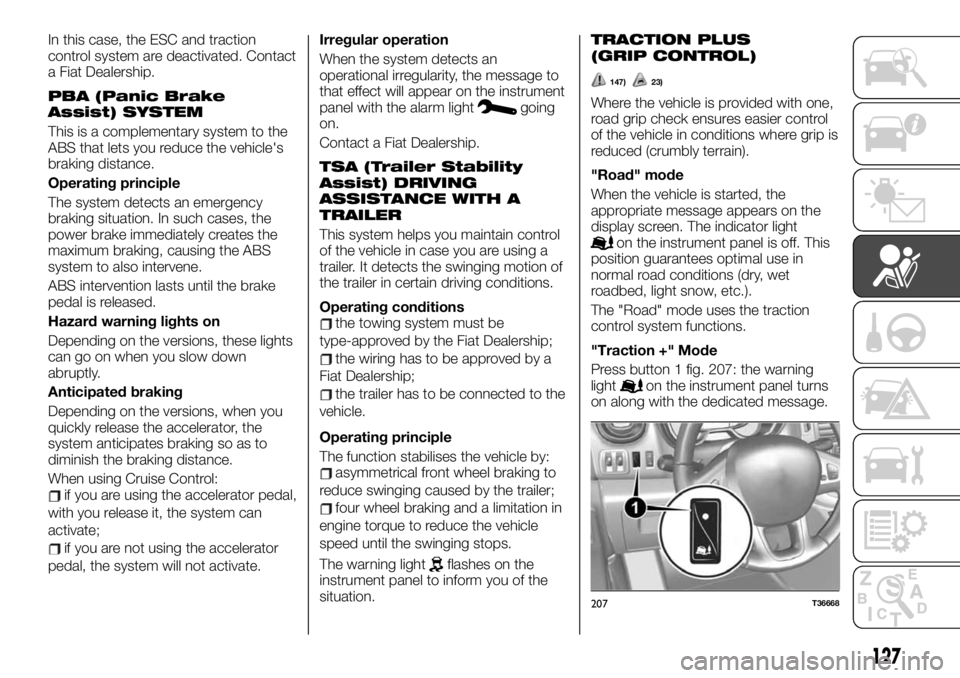
In this case, the ESC and traction
control system are deactivated. Contact
a Fiat Dealership.
PBA (Panic Brake
Assist) SYSTEM
This is a complementary system to the
ABS that lets you reduce the vehicle's
braking distance.
Operating principle
The system detects an emergency
braking situation. In such cases, the
power brake immediately creates the
maximum braking, causing the ABS
system to also intervene.
ABS intervention lasts until the brake
pedal is released.
Hazard warning lights on
Depending on the versions, these lights
can go on when you slow down
abruptly.
Anticipated braking
Depending on the versions, when you
quickly release the accelerator, the
system anticipates braking so as to
diminish the braking distance.
When using Cruise Control:
if you are using the accelerator pedal,
with you release it, the system can
activate;
if you are not using the accelerator
pedal, the system will not activate.Irregular operation
When the system detects an
operational irregularity, the message to
that effect will appear on the instrument
panel with the alarm light
going
on.
Contact a Fiat Dealership.
TSA (Trailer Stability
Assist) DRIVING
ASSISTANCE WITH A
TRAILER
This system helps you maintain control
of the vehicle in case you are using a
trailer. It detects the swinging motion of
the trailer in certain driving conditions.
Operating conditions
the towing system must be
type-approved by the Fiat Dealership;
the wiring has to be approved by a
Fiat Dealership;
the trailer has to be connected to the
vehicle.
Operating principle
The function stabilises the vehicle by:
asymmetrical front wheel braking to
reduce swinging caused by the trailer;
four wheel braking and a limitation in
engine torque to reduce the vehicle
speed until the swinging stops.
The warning light
flashes on the
instrument panel to inform you of the
situation.
TRACTION PLUS
(GRIP CONTROL)
147) 23)
Where the vehicle is provided with one,
road grip check ensures easier control
of the vehicle in conditions where grip is
reduced (crumbly terrain).
"Road" mode
When the vehicle is started, the
appropriate message appears on the
display screen. The indicator light
on the instrument panel is off. This
position guarantees optimal use in
normal road conditions (dry, wet
roadbed, light snow, etc.).
The "Road" mode uses the traction
control system functions.
"Traction +" Mode
Press button 1 fig. 207: the warning
light
on the instrument panel turns
on along with the dedicated message.
207T36668
127
Page 130 of 236
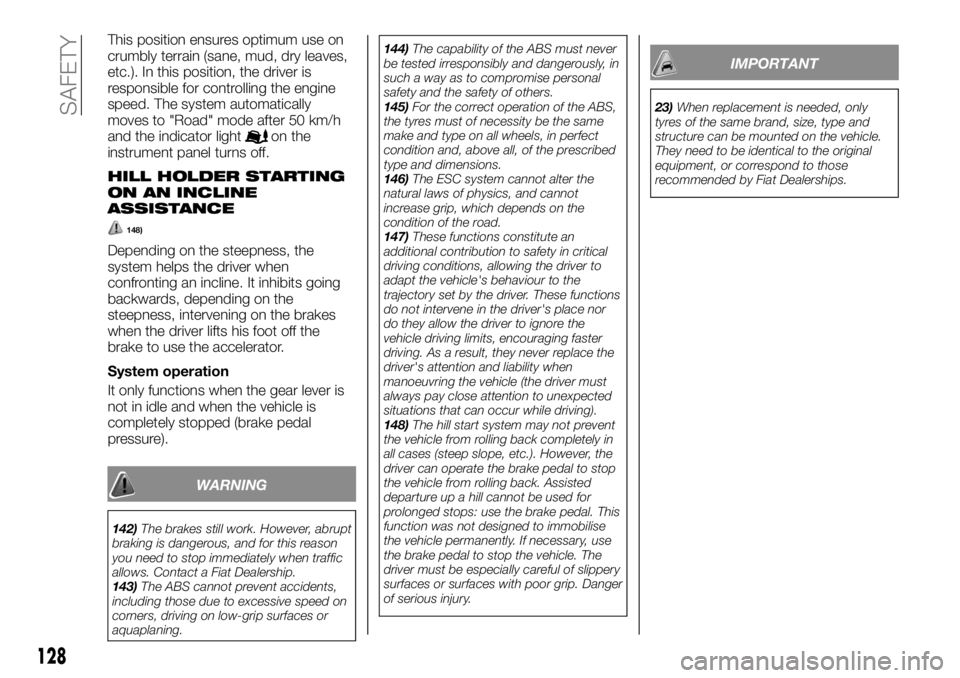
This position ensures optimum use on
crumbly terrain (sane, mud, dry leaves,
etc.). In this position, the driver is
responsible for controlling the engine
speed. The system automatically
moves to "Road" mode after 50 km/h
and the indicator light
on the
instrument panel turns off.
HILL HOLDER STARTING
ON AN INCLINE
ASSISTANCE
148)
Depending on the steepness, the
system helps the driver when
confronting an incline. It inhibits going
backwards, depending on the
steepness, intervening on the brakes
when the driver lifts his foot off the
brake to use the accelerator.
System operation
It only functions when the gear lever is
not in idle and when the vehicle is
completely stopped (brake pedal
pressure).
WARNING
142)The brakes still work. However, abrupt
braking is dangerous, and for this reason
you need to stop immediately when traffic
allows. Contact a Fiat Dealership.
143)The ABS cannot prevent accidents,
including those due to excessive speed on
corners, driving on low-grip surfaces or
aquaplaning.144)The capability of the ABS must never
be tested irresponsibly and dangerously, in
such a way as to compromise personal
safety and the safety of others.
145)For the correct operation of the ABS,
the tyres must of necessity be the same
make and type on all wheels, in perfect
condition and, above all, of the prescribed
type and dimensions.
146)The ESC system cannot alter the
natural laws of physics, and cannot
increase grip, which depends on the
condition of the road.
147)These functions constitute an
additional contribution to safety in critical
driving conditions, allowing the driver to
adapt the vehicle's behaviour to the
trajectory set by the driver. These functions
do not intervene in the driver's place nor
do they allow the driver to ignore the
vehicle driving limits, encouraging faster
driving. As a result, they never replace the
driver's attention and liability when
manoeuvring the vehicle (the driver must
always pay close attention to unexpected
situations that can occur while driving).
148)The hill start system may not prevent
the vehicle from rolling back completely in
all cases (steep slope, etc.). However, the
driver can operate the brake pedal to stop
the vehicle from rolling back. Assisted
departure up a hill cannot be used for
prolonged stops: use the brake pedal. This
function was not designed to immobilise
the vehicle permanently. If necessary, use
the brake pedal to stop the vehicle. The
driver must be especially careful of slippery
surfaces or surfaces with poor grip. Danger
of serious injury.
IMPORTANT
23)When replacement is needed, only
tyres of the same brand, size, type and
structure can be mounted on the vehicle.
They need to be identical to the original
equipment, or correspond to those
recommended by Fiat Dealerships.
128
SAFETY
Page 131 of 236
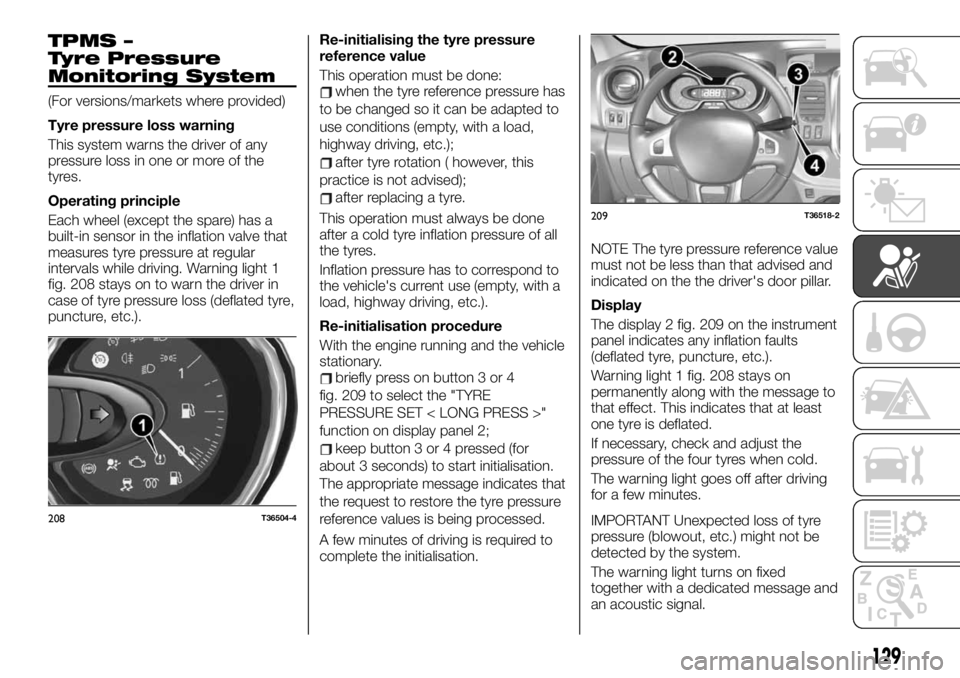
TPMS –
Tyre Pressure
Monitoring System
(For versions/markets where provided)
Tyre pressure loss warning
This system warns the driver of any
pressure loss in one or more of the
tyres.
Operating principle
Each wheel (except the spare) has a
built-in sensor in the inflation valve that
measures tyre pressure at regular
intervals while driving. Warning light 1
fig. 208 stays on to warn the driver in
case of tyre pressure loss (deflated tyre,
puncture, etc.).Re-initialising the tyre pressure
reference value
This operation must be done:when the tyre reference pressure has
to be changed so it can be adapted to
use conditions (empty, with a load,
highway driving, etc.);
after tyre rotation ( however, this
practice is not advised);
after replacing a tyre.
This operation must always be done
after a cold tyre inflation pressure of all
the tyres.
Inflation pressure has to correspond to
the vehicle's current use (empty, with a
load, highway driving, etc.).
Re-initialisation procedure
With the engine running and the vehicle
stationary.
briefly press on button 3 or 4
fig. 209 to select the "TYRE
PRESSURE SET < LONG PRESS >"
function on display panel 2;
keep button 3 or 4 pressed (for
about 3 seconds) to start initialisation.
The appropriate message indicates that
the request to restore the tyre pressure
reference values is being processed.
A few minutes of driving is required to
complete the initialisation.NOTE The tyre pressure reference value
must not be less than that advised and
indicated on the the driver's door pillar.
Display
The display 2 fig. 209 on the instrument
panel indicates any inflation faults
(deflated tyre, puncture, etc.).
Warning light 1 fig. 208 stays on
permanently along with the message to
that effect. This indicates that at least
one tyre is deflated.
If necessary, check and adjust the
pressure of the four tyres when cold.
The warning light goes off after driving
for a few minutes.
IMPORTANT Unexpected loss of tyre
pressure (blowout, etc.) might not be
detected by the system.
The warning light turns on fixed
together with a dedicated message and
an acoustic signal.
208T36504-4
209T36518-2
129
Page 132 of 236
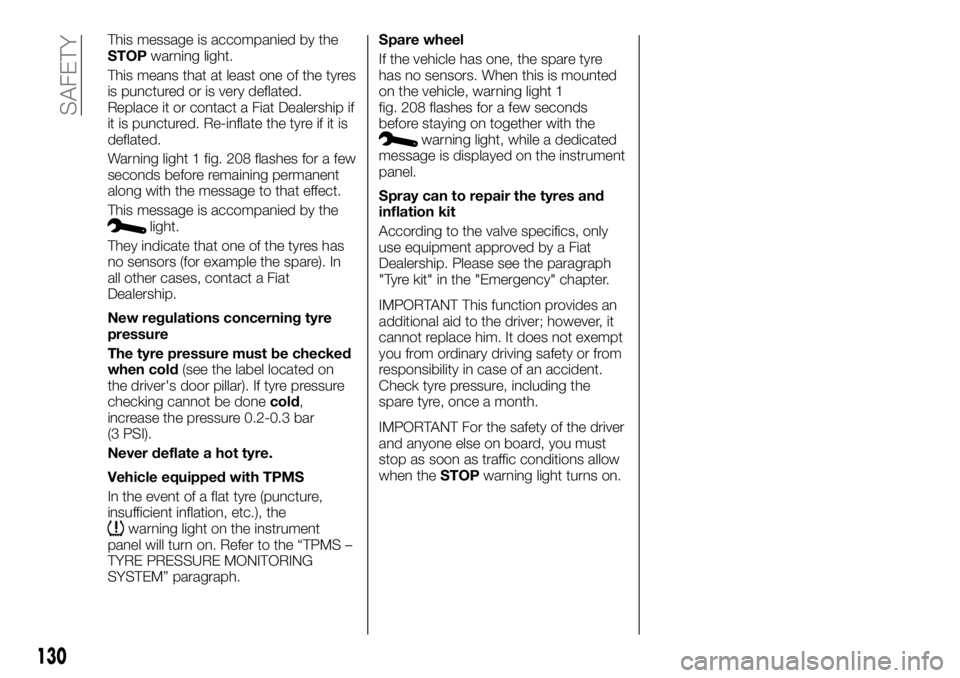
This message is accompanied by the
STOPwarning light.
This means that at least one of the tyres
is punctured or is very deflated.
Replace it or contact a Fiat Dealership if
it is punctured. Re-inflate the tyre if it is
deflated.
Warning light 1 fig. 208 flashes for a few
seconds before remaining permanent
along with the message to that effect.
This message is accompanied by the
light.
They indicate that one of the tyres has
no sensors (for example the spare). In
all other cases, contact a Fiat
Dealership.
New regulations concerning tyre
pressure
The tyre pressure must be checked
when cold(see the label located on
the driver's door pillar). If tyre pressure
checking cannot be donecold,
increase the pressure 0.2-0.3 bar
(3 PSI).
Never deflate a hot tyre.
Vehicle equipped with TPMS
In the event of a flat tyre (puncture,
insufficient inflation, etc.), the
warning light on the instrument
panel will turn on. Refer to the “TPMS –
TYRE PRESSURE MONITORING
SYSTEM” paragraph.Spare wheel
If the vehicle has one, the spare tyre
has no sensors. When this is mounted
on the vehicle, warning light 1
fig. 208 flashes for a few seconds
before staying on together with the
warning light, while a dedicated
message is displayed on the instrument
panel.
Spray can to repair the tyres and
inflation kit
According to the valve specifics, only
use equipment approved by a Fiat
Dealership. Please see the paragraph
"Tyre kit" in the "Emergency" chapter.
IMPORTANT This function provides an
additional aid to the driver; however, it
cannot replace him. It does not exempt
you from ordinary driving safety or from
responsibility in case of an accident.
Check tyre pressure, including the
spare tyre, once a month.
IMPORTANT For the safety of the driver
and anyone else on board, you must
stop as soon as traffic conditions allow
when theSTOPwarning light turns on.
130
SAFETY
Page 134 of 236
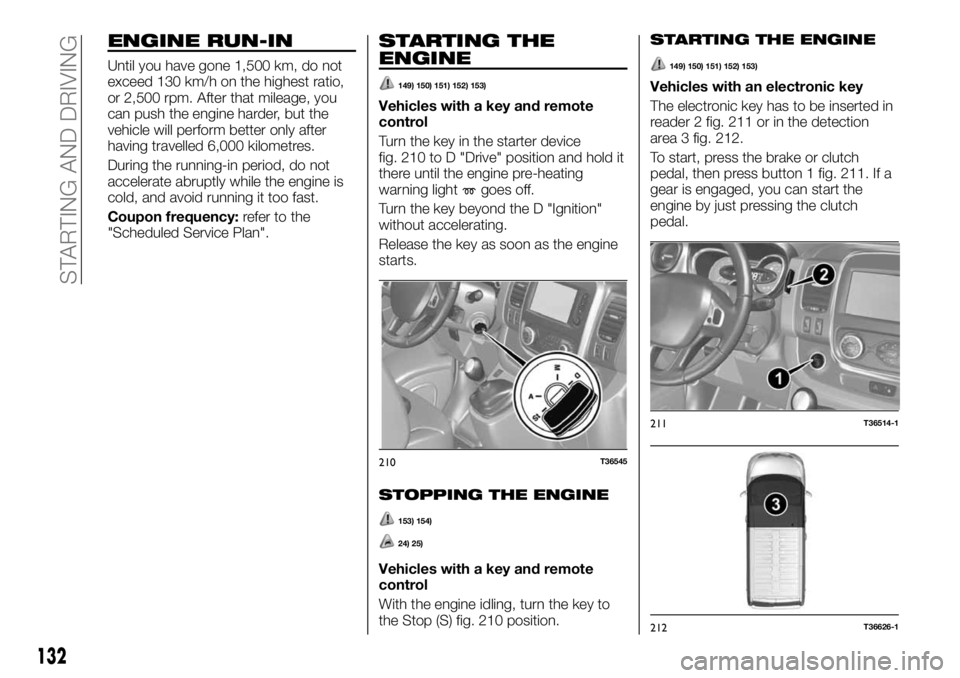
ENGINE RUN-IN
Until you have gone 1,500 km, do not
exceed 130 km/h on the highest ratio,
or 2,500 rpm. After that mileage, you
can push the engine harder, but the
vehicle will perform better only after
having travelled 6,000 kilometres.
During the running-in period, do not
accelerate abruptly while the engine is
cold, and avoid running it too fast.
Coupon frequency:refer to the
"Scheduled Service Plan".
STARTING THE
ENGINE
149) 150) 151) 152) 153)
Vehicles with a key and remote
control
Turn the key in the starter device
fig. 210 to D "Drive" position and hold it
there until the engine pre-heating
warning light
goes off.
Turn the key beyond the D "Ignition"
without accelerating.
Release the key as soon as the engine
starts.
STOPPING THE ENGINE
153) 154)
24) 25)
Vehicles with a key and remote
control
With the engine idling, turn the key to
the Stop (S) fig. 210 position.
STARTING THE ENGINE
149) 150) 151) 152) 153)
Vehicles with an electronic key
The electronic key has to be inserted in
reader 2 fig. 211 or in the detection
area 3 fig. 212.
To start, press the brake or clutch
pedal, then press button 1 fig. 211. If a
gear is engaged, you can start the
engine by just pressing the clutch
pedal.
210T36545
211T36514-1
212T36626-1
132
STARTING AND DRIVING
Page 136 of 236
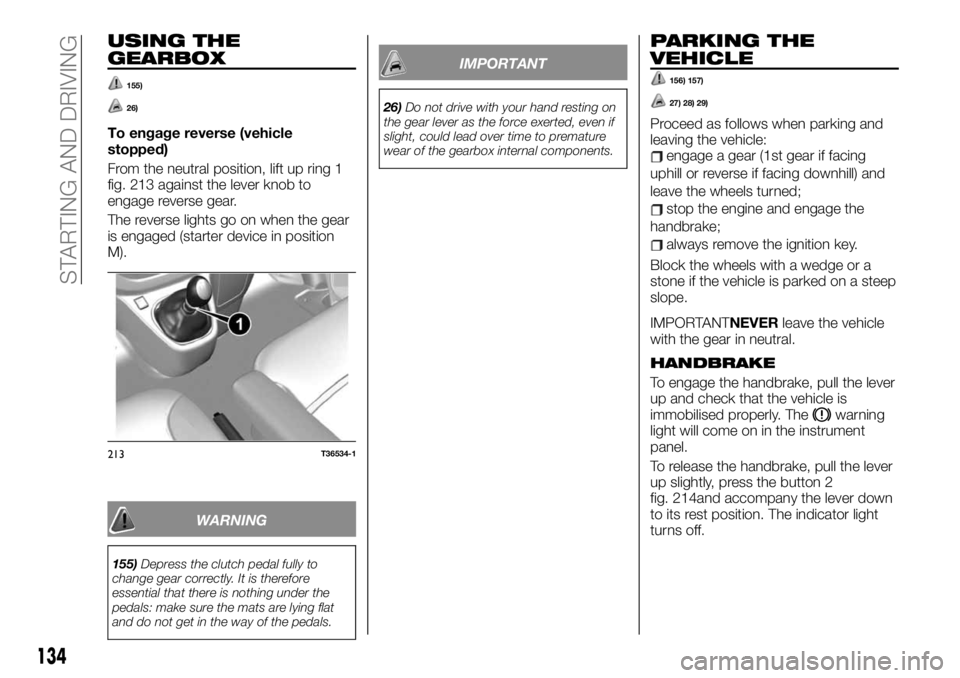
USING THE
GEARBOX
155)
26)
To engage reverse (vehicle
stopped)
From the neutral position, lift up ring 1
fig. 213 against the lever knob to
engage reverse gear.
The reverse lights go on when the gear
is engaged (starter device in position
M).
WARNING
155)Depress the clutch pedal fully to
change gear correctly. It is therefore
essential that there is nothing under the
pedals: make sure the mats are lying flat
and do not get in the way of the pedals.
IMPORTANT
26)Do not drive with your hand resting on
the gear lever as the force exerted, even if
slight, could lead over time to premature
wear of the gearbox internal components.
PARKING THE
VEHICLE
156) 157)
27) 28) 29)
Proceed as follows when parking and
leaving the vehicle:
engage a gear (1st gear if facing
uphill or reverse if facing downhill) and
leave the wheels turned;
stop the engine and engage the
handbrake;
always remove the ignition key.
Block the wheels with a wedge or a
stone if the vehicle is parked on a steep
slope.
IMPORTANTNEVERleave the vehicle
with the gear in neutral.
HANDBRAKE
To engage the handbrake, pull the lever
up and check that the vehicle is
immobilised properly. The
warning
light will come on in the instrument
panel.
To release the handbrake, pull the lever
up slightly, press the button 2
fig. 214and accompany the lever down
to its rest position. The indicator light
turns off.
213T36534-1
134
STARTING AND DRIVING
Page 137 of 236
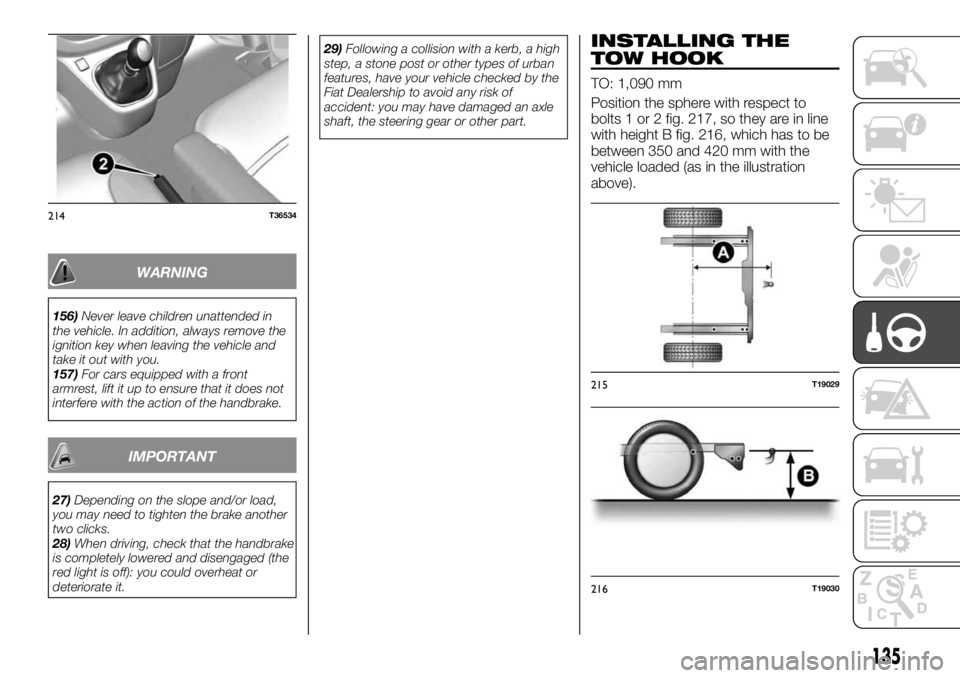
WARNING
156)Never leave children unattended in
the vehicle. In addition, always remove the
ignition key when leaving the vehicle and
take it out with you.
157)For cars equipped with a front
armrest, lift it up to ensure that it does not
interfere with the action of the handbrake.
IMPORTANT
27)Depending on the slope and/or load,
you may need to tighten the brake another
two clicks.
28)When driving, check that the handbrake
is completely lowered and disengaged (the
red light is off): you could overheat or
deteriorate it.29)Following a collision with a kerb, a high
step, a stone post or other types of urban
features, have your vehicle checked by the
Fiat Dealership to avoid any risk of
accident: you may have damaged an axle
shaft, the steering gear or other part.
INSTALLING THE
TOW HOOK
TO: 1,090 mm
Position the sphere with respect to
bolts 1 or 2 fig. 217, so they are in line
with height B fig. 216, which has to be
between 350 and 420 mm with the
vehicle loaded (as in the illustration
above).
214T36534
215T19029
216T19030
135
Page 140 of 236
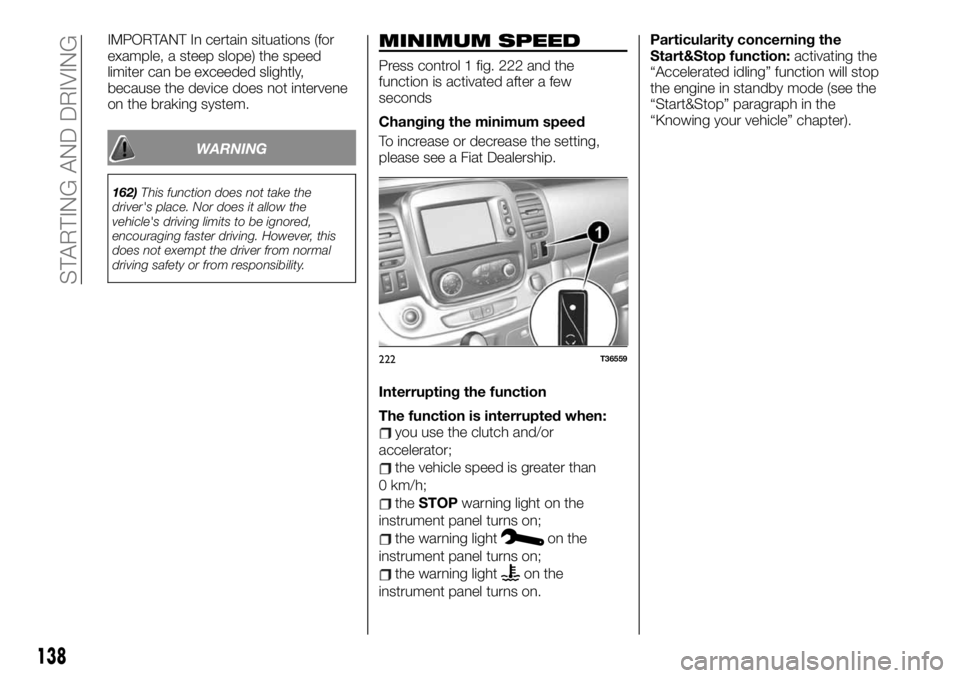
IMPORTANT In certain situations (for
example, a steep slope) the speed
limiter can be exceeded slightly,
because the device does not intervene
on the braking system.
WARNING
162)This function does not take the
driver's place. Nor does it allow the
vehicle's driving limits to be ignored,
encouraging faster driving. However, this
does not exempt the driver from normal
driving safety or from responsibility.
MINIMUM SPEED
Press control 1 fig. 222 and the
function is activated after a few
seconds
Changing the minimum speed
To increase or decrease the setting,
please see a Fiat Dealership.
Interrupting the function
The function is interrupted when:
you use the clutch and/or
accelerator;
the vehicle speed is greater than
0 km/h;
theSTOPwarning light on the
instrument panel turns on;
the warning lighton the
instrument panel turns on;
the warning lighton the
instrument panel turns on.Particularity concerning the
Start&Stop function:activating the
“Accelerated idling” function will stop
the engine in standby mode (see the
“Start&Stop” paragraph in the
“Knowing your vehicle” chapter).
222T36559
138
STARTING AND DRIVING
Page 141 of 236
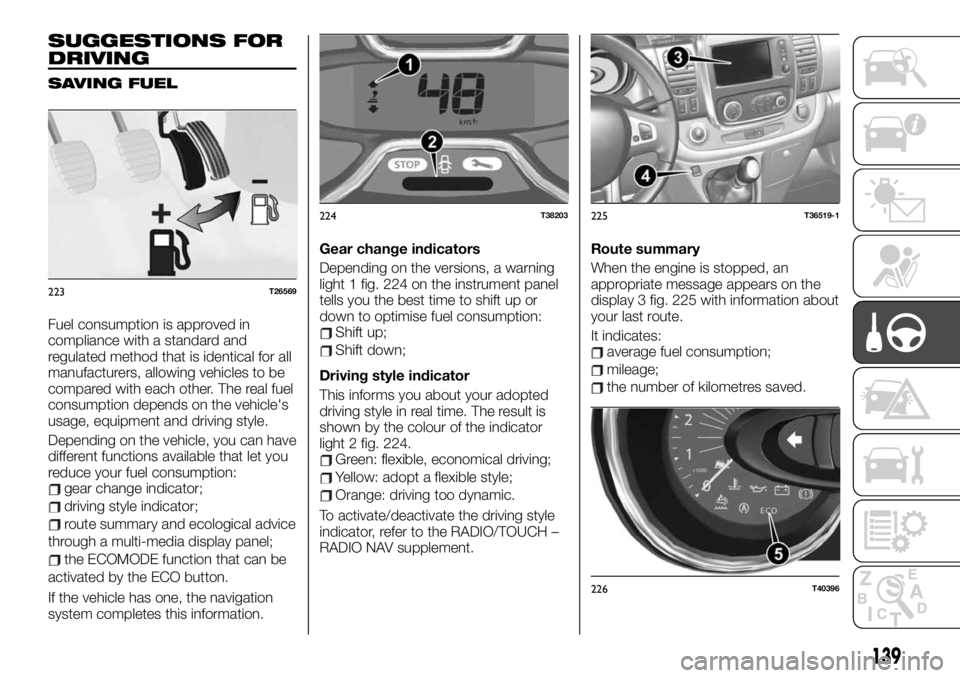
SUGGESTIONS FOR
DRIVING
SAVING FUEL
Fuel consumption is approved in
compliance with a standard and
regulated method that is identical for all
manufacturers, allowing vehicles to be
compared with each other. The real fuel
consumption depends on the vehicle's
usage, equipment and driving style.
Depending on the vehicle, you can have
different functions available that let you
reduce your fuel consumption:
gear change indicator;
driving style indicator;
route summary and ecological advice
through a multi-media display panel;
the ECOMODE function that can be
activated by the ECO button.
If the vehicle has one, the navigation
system completes this information.Gear change indicators
Depending on the versions, a warning
light 1 fig. 224 on the instrument panel
tells you the best time to shift up or
down to optimise fuel consumption:
Shift up;
Shift down;
Driving style indicator
This informs you about your adopted
driving style in real time. The result is
shown by the colour of the indicator
light 2 fig. 224.
Green: flexible, economical driving;
Yellow: adopt a flexible style;
Orange: driving too dynamic.
To activate/deactivate the driving style
indicator, refer to the RADIO/TOUCH –
RADIO NAV supplement.Route summary
When the engine is stopped, an
appropriate message appears on the
display 3 fig. 225 with information about
your last route.
It indicates:
average fuel consumption;
mileage;
the number of kilometres saved.
223T26569
224T38203225T36519-1
226T40396
139